
February 5 / TS-11 Iskra first flight
First Flight 5 February 1960
PZL TS-11 Iskra
The PZL TS-11 Iskra (English: Spark) is a Polish jet trainer, developed and manufactured by aircraft company PZL-Mielec. It was used by the air forces of Poland and India. It is notable as being the first domestically developed jet aircraft to be produced by Poland, its service for over 50 years as the principal training aircraft of the Polish Air Force, and at the time of its retirement was the oldest jet-propelled aircraft still in service in Poland.
As a part of efforts to preserve Poland's ability to independently develop aircraft in an era of political and economic subservience to the neighbouring Soviet Union, during the 1950s, Polish engineers at Poland's Aviation Institute (IL) commenced early work on the design of what would become the first jet aircraft to be developed in Poland. Following the death of Joseph Stalin, work on the initiative could be performed more openly and government officials became supportive of such a venture. The fledgling design was heavily influenced by the requirements specified by the Polish Air Force, which had formalised a requirement for a jet-propelled aircraft for training purposes. On 5 February 1960, the first prototype conducted its maiden flight, powered by an imported British Armstrong Siddeley Viper turbojet engine.
In 1963, deliveries of the first production model of the type, designated as the TS-11 Iskra bis A, commenced to the Polish Air Force. During the 1960s, the Iskra competed to be selected as the standard jet trainer throughout the Warsaw Pact. However, it was not selected to fulfil this significant role, the rival Czechoslovakian Aero L-29 Delfín was chosen instead, which went on to be built in greater numbers for a wide number of export customers. Production of the TS-11 came to an end in 1987, however, the type remained in service with the Polish Air Force and the Indian Air Force into the 21st century. From 1969 onwards, a handful of TS-11s have been used by the Polish Air Force's Bialo-Czerwone Iskry aerobatics display team, who performed their last display on 22 August 2021. It has also been used for aerial reconnaissance purposes. During the aircraft's later years of service, several examples have been sold onto private owners.
Following the end of World War II, Poland was politically dominated by the neighbouring Soviet Union; as a consequence, the Polish aviation industry underwent vast changes at the behest of the Soviets. According to aviation author Jerzy K. Cynk, the immediate post-war decade was a period of frustrated efforts and disappointments, by early 1951, all of the nation's design offices had been dissolved and the entirety of indigenous projects were terminated. Instead, Poland's aircraft factories were assigned to produce mainly Russian-sourced military-orientated equipment to meet the requirements of the Soviet war machine, such as the Mikoyan-Gurevich MiG-17 fighter aircraft. Shortly following the death of Soviet leader Joseph Stalin, military orders were drastically cut, leading to Polish aircraft plants falling idle and some being permanently closed down.
While the nation's design offices had been liquidated, some former members had joined Poland's Aviation Institute (1L) and performed some limited work on various original projects, even though such efforts were initially officially discouraged. As such, it was at IL that the effort to design would become the first jet aircraft to be developed in Poland originated; however, during the late 1950s, responsibility for the design work on the program was transferred to aircraft manufacturer PZL-Mielec at an early stage in order that IL could resume its primary mission of scientific and technological research. Much of the design work on the program was produced in response to the specified needs of a requirement issued by the Polish Air Force for a capable jet-propelled trainer aircraft, which was seeking a replacement for the piston-engined PZL TS-8 Bies at the time.
Polish government officials came to openly regard the project as being of considerable importance to the nation's aviation industry, thus vigorous efforts were made to support the development of the TS-11. The main designer was Polish aeronautical engineer Tadeusz Sołtyk; his initials were the source for part of the type's official designation TS-11. Early on, it was decided to adopt a foreign-sourced turbojet engine to power the aircraft. Quickly, the British Armstrong Siddeley Viper emerged as the company's favoured option; however, reportedly, negotiations for its acquisition eventually broke down; accordingly, work on the project was delayed until a suitable domestically built powerplant had reached an advanced stage of development.
On 5 February 1960, the first prototype conducted its maiden flight, powered by an imported Viper 8 engine, capable of producing up to 7.80 kN (1,750 lbf) of thrust. On 11 September 1960, the aircraft's existence was publicly revealed during an aerial display held over Lodz. The next pair of prototypes, which performed their first flights during March and July 1961 respectively, were instead powered by a Polish copy of the Viper engine, designated as the WSK HO-10. The flight test program that the three prototypes were subjected to had both demonstrated the capabilities of the new aircraft and its suitability for satisfying the Polish Air Force's stated requirements for a trainer jet; as such, it was soon accepted by the Polish Air Force.
In 1963, the first production model of the type, designated as the TS-11 Iskra bis A, commenced delivery to the service. From about 1966, new-build aircraft were furnished with a newer Polish-designed turbojet engine, designated as the WSK SO-1, which was capable of producing up to 9.80 kN (2,200 lbf) of thrust and reportedly gave the TS-11 a top speed of 497 mph. From 1969 onwards, the improved WSK SO-3 engine became available, offering considerably longer times between overhauls; this engine was later improved into the WSK SO-3W, which was able to generate 10.80 kN (2,425 lbf) of thrust.








